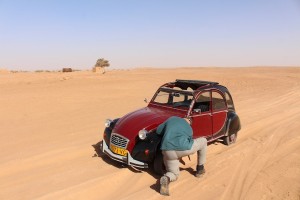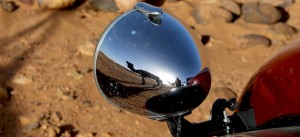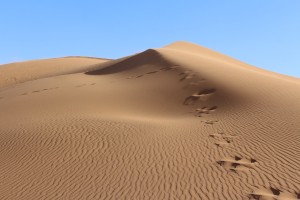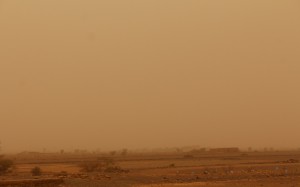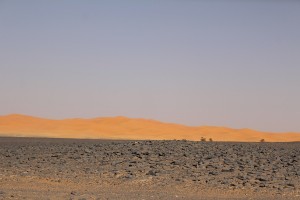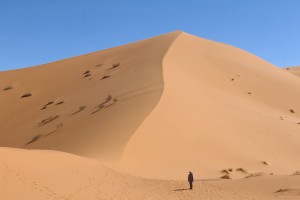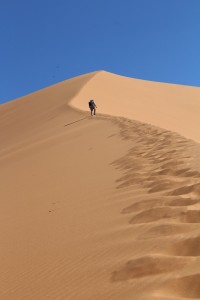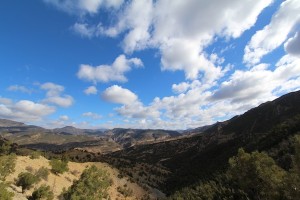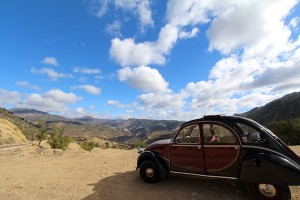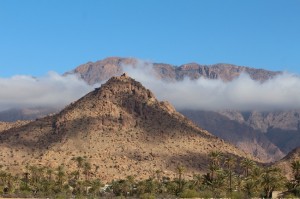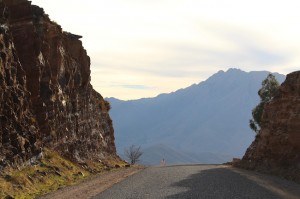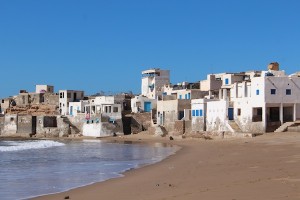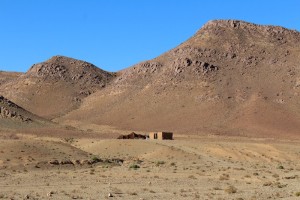Sweet almond oases, wind swept mountains, lute-playing paratroopers, Keith Richards lookalikes, a pyramid man and Billy The Kid Elliot – just some of the places and characters we have encountered.
Just outside Tafraoute is a picture perfect oasis – complete with a well, almond blossom and palm trees.

An idyllic watering hole – the well, almond blossom and palm trees make a picture postcard
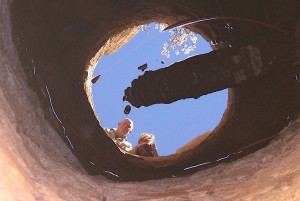
Well, well.

A traditional Berber village near Tafraoute
It was a beautiful and tranquil spot. The delicate blossoms were soon replaced with craggy windswept mountains as we crossed the Jebel Bani and head toward the desert.

The drama of the geography never gets old

Heat and sand in the foreground, snow-capped mountains in the distance
The ever-changing landscape of Morocco is a daily delight, altering sometimes by the hour as we travel, from the high sided canyons of the Ait Mansour gorge….
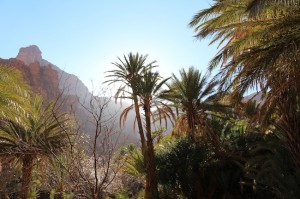
The setting sun glints through the palms of Ait Mansour Gorge

Homes melt into the mountain in Ait Mansour gorge
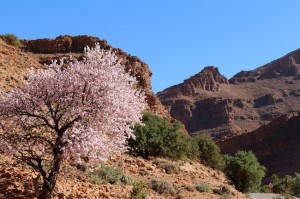
A sweet almond welcome to the start of the Ait Mansour Gorge
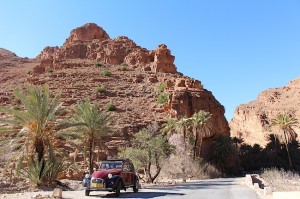
At the end of the Ait Mansour gorge
to the surprising oasis in a gully barely visible just a few feet away…..

The desert floor above

The oasis below, with houses and animal pens

We found this lush oasis with three houses in the bottom of a canyon in the middle of nowhere
to the endless skylines of the Atlas Mountains.

The wind fashions the rock into great grooves and gullies

Just one part of the Atlas mountains
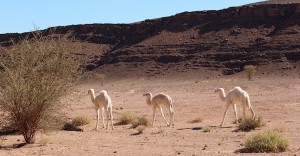
Too cute – wild white baby camels

More switchbacks to turn and mountains to climb en-route

In some parts of the mountains, women almost only ever wear black

Coming home from the market

History and hardship is etched on his face

Age, authority and groovy green specs

Desert sands, mountains, palms, earth brick houses and a sat dish…. Sky Sports anyone?
We stopped for a couple of nights at Agdz – a pivot point from which you can head north toward Marrakech or, in our case, south to the desert.

It’s hard to imagine the building is centuries old
We have been confused about the difference between a kasbah a, riads, ksars and such like – so now we know, we can pass it on.
A kasbah is a walled private house.

This courtyard was originally the kitchen, hammam and stables
A riad is a walled garden with trees. It has become synonymous with a guest house these days, especially in Marrakech, but a night in a real riad will leave you outside hugging a fruit tree!
- The riad – or walled garden. Sadly the orange trees around the fountain are gone
A ksar is a walled village.

The ksar (walled village) next to the kasbah (walled house)
In theory you can have a riad inside a kasbah inside a ksar….. but we digress.
So, back to the kasbah – built with earth bricks, baked hard in the sun and a richly painted interior.
The first level of bricks are always the same dimensions – 1mx50cmx50cm. They are built insitu and then left to bake in the sun and air until strong enough to take the rest of the building… no chance of a 12 week finish or your money back here.

What an entrance!
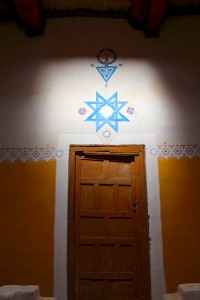
Traditional and modern design in the ancient kasbah

Treasure chest for women’s secret things

The decorations are particular to this family

Special windows for women, so they can see out, but they cannot be seen

A door within a door, leading to the summer room

Pitcher of water in a window alcove

Lounging

Just a place to sit

The door frames are made of palm trees
It was an interesting tour, but we found the descriptions of the family dynamics much more fascinating. How do you sort out who gets what when there are nine brothers….. Not easily or happily apparently!
Inter-familia disputes are a far cry from the laid back attitude of brothers Abdulliah and Belaid, who greeted us and then oft- repeated their mantra ” take your time” as we pulled into their aptly named
Prends ton Temps (Take Your Time) campsite in Zagora.

Abdullaih and Belaid
Zagora is known as the gateway to the Sahara in Morocco.

The wall says we are in the desert
Belaid spent 21 years in the Moroccan army as a paratrooper, eleven of those years in the desert on the disputed Moroccan/Algerian border. He’s the size of a shed, with a sun-splitting smile and likes nothing better these days than playing his eleven-string lute.

Belaid Laalili playing the eleven-string lute
Abdulliah is pencil thin with more than a passing resemblance to Keith Richards and just as full of bonhomie as his brother. They make a great pair and were easy-going, charming hosts.

Take your time, boys

This is just the working model size

Technical drawings
A six-pointed star made of multiple equilateral triangles. The real thing will be about four- storeys high and if you like the look of it, he’s looking for sponsors.

The artist at work

The scale is ambitious, but rather appealing
Not taking his time at all was the camp goat.

Billy “the Kid” Elliot and his mum
For his constant dancing and prancing around the site, we named him Billy Elliot and delighted in his endless excitement and amazement of the world around him – we know the feeling!
As usual there are plenty more photos in the slideshow, so…kick back, take your time and enjoy the show.


